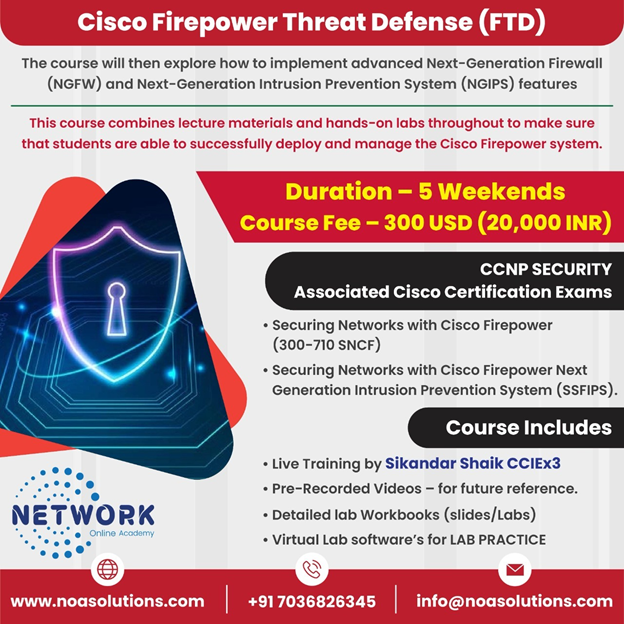Online Courses
- 1. Cisco Certified Network Associate - CCNA 200-301
- 2. CCNP ENTERPRISE – Core 350-401
- 3. CCNP ENTERPRISE – Advanced Routing 300-410
- 4. CCNP ENTERPRISE – SDWAN 300-415 – WAN Automation
- 5. SD-ACCESS – Cisco DNAC- LAN Automation
- 6. CCNP SECURITY - 350-701 Security Core
- 7. CCNP SECURITY - 300-730 Virtual Private Networks (VPN)
- 8. CCNP SECURITY - 300-710 Firepower + NGIPS
- 9. CCNP SECURITY – Web /Email Security (300-720/725)
- 10. CCNP SECURITY - 300-715 Identity Service Engine (ISE)
- 11. CCNP SERVICE PROVIDER – 350-501 Core
- 12. CCNP SERVICE PROVIDER – 350-510 Advanced Routing
- 13. CCNP SERVICE PROVIDER – 300-515 VPN Services
- 14. CCNP DATACENTER – 350-601 Core
- 15. CCNP DATACENTER – 300-620 ACI (Application Centric Infrastructure)
- 16. CCNP DATACENTER – Nexus
- 17. CCIE ENTPERISE INFRASTRUCTURE
- 18. CCIE Security
- 19. CCIE Service Provider
- 20. JNCIA - Enterprise Routing and Switching (JN0-102)
- 21. Cisco ASA firewall / Cisco Firepower-
- 22. Checkpoint Firewall (CCSA)
- 23. Fortigate Firewall (NSE 4-5 )
- 24. PaloAlto Firewall
- 25. F5 Load balancers – LTM
- 26. Python Programming – for Network Engineers
- 27. CCNA Devnet – 300-901
- 28. Cisco Ansible- Automating networks
- 29. Microsoft Certified Engineer ( MCSE 2016)
- 30. Vmware Vsphere 6.5
- 31. AWS Solutions Architect
- 32. Microsoft Azure Administrator

CCNP SECURITY - 300-710 Firepower + NGIPS
Duration – 6 Weeks ( 120 hrs/day)
Price – 20,000 INR ( 300 USD )
DEMO VIDEO (YouTube links)
Training Program Includes
Contact us to reserve your slot for Online Trainings
For more Details Mail us on info@noasolutions.com
Faster communication – WhatsApp – +91 7036826345
Course Content
The Securing Networks with Cisco Firepower v1.0 (SNCF 300-710) exam is a 90-minute exam associated with the CCNP Security, and Cisco Certified Specialist – Network Security Firepower certifications.
This course will help you:
- Implement Cisco Firepower Next-Generation IPS to stop threats
- Address attacks
- Increase vulnerability prevention against suspicious files
- analyze for not-yet-identified threats
- Gain leading-edge skills for high-demand responsibilities focused on security
- How to use and configure Cisco Firepower Threat Defense technology
- Beginning with initial device setup
- Configuration - Routing, High availability
- Cisco ASA to Firepower Threat Defense migration
- Traffic control
- Network Address Translation (NAT)
The course will then explore how to implement advanced Next-Generation Firewall (NGFW) and Next-Generation Intrusion Prevention System (NGIPS) features,
- including network intelligence,
- file type detection,
- network-based malware detection,
- deep packet inspection.
Students will also learn how to
- Configure site-to-site VPN,
- Remote-access VPN,
- SSL decryption before moving on to detailed analysis, system administration, and troubleshooting.
This course combines lecture materials and hands-on labs throughout to make sure that students are able to successfully deploy and manage the Cisco Firepower system.
After you pass 300-710 SNCF:
- You earn the Cisco Certified Specialist - Network Security Firepower certification.
- You will have satisfied the concentration exam requirement for new CCNP Security certification.
- To complete CCNP Security, you also need to pass the Implementing and Operating Cisco Security Core Technologies (350-701 SCOR) exam or its equivalent.
Course prerequisites
- Knowledge of TCP/IP and basic routing protocols, and familiarity with firewall, VPN, and IPS concepts
Course objectives
Upon completion of this course, you should be able to:
- Describe key concepts of NGIPS and NGFW technology and the Cisco Firepower Threat Defense system,
- Identify deployment scenarios
- Perform initial Firepower Threat Defense device configuration and setup tasks
- Describe how to manage traffic and implement Quality of Service (QoS) using Cisco Firepower Threat
- Defense
- Describe how to implement NAT by using Cisco Firepower Threat Defense
- Perform an initial network discovery, using Cisco Firepower to identify hosts, applications, and services
- Describe the behavior, usage, and implementation procedure for access control policies
- Describe the concepts and procedures for implementing security Intelligence features
- Describe Cisco AMP for Networks and the procedures for implementing file control and Advanced Malware
- Protection
- Implement and manage intrusion policies
- Describe the components and configuration of site-to-site VPN
- Describe and configure a remote-access SSL VPN that uses Cisco AnyConnect®
- Describe SSL decryption capabilities and usage
Course outline
- Cisco Firepower Threat Defense Overview
- Firepower NGFW Device Configuration
- Firepower NGFW Traffic Control
- Firepower NGFW Address Translation
- Firepower Discovery
- Implementing Access Control Policies
- Security Intelligence
- File Control and Advanced Malware Protection
- Next-Generation Intrusion Prevention Systems
- Site-to-Site VPN
- Remote-Access VPN
- SSL Decryption
- Detailed Analysis Techniques
- System Administration
- Firepower Troubleshooting
Lab Outline
- Lab 1: Initial Device Setup
- Lab 2: Device Management
- Lab 3: Configuring High Availability
- Lab 4: Migrating from Cisco ASA to Firepower Threat Defense
- Lab 5: Implementing QoS
- Lab 6: Implementing NAT
- Lab 7: Configuring Network Discovery
- Lab 8: Implementing an Access Control Policy
- Lab 9: Implementing Security Intelligence
- Lab 10: Implementing Site-to-Site VPN
- Lab 11: Implementing Remote Access VPN
- Lab 12: Threat Analysis
- Lab 13: System Administration
- Lab 14: Firepower Troubleshooting

